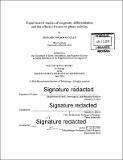| dc.contributor.advisor | Timothy L. Grove. | en_US |
| dc.contributor.author | Mandler, Benjamin Ehrlich | en_US |
| dc.contributor.other | Massachusetts Institute of Technology. Department of Earth, Atmospheric, and Planetary Sciences. | en_US |
| dc.date.accessioned | 2016-09-30T19:37:06Z | |
| dc.date.available | 2016-09-30T19:37:06Z | |
| dc.date.copyright | 2016 | en_US |
| dc.date.issued | 2016 | en_US |
| dc.identifier.uri | http://hdl.handle.net/1721.1/104588 | |
| dc.description | Thesis: Ph. D., Massachusetts Institute of Technology, Department of Earth, Atmospheric, and Planetary Sciences, 2016. | en_US |
| dc.description | Cataloged from PDF version of thesis. | en_US |
| dc.description | Includes bibliographical references. | en_US |
| dc.description.abstract | This thesis primarily investigates how the conditions of crystallization affect the chemical evolution of magmas. A major focus is the effect of water on the stability of mineral phases, and how this affects both the differentiation of magmas and the modification of the upper mantle by hydrous fluid release during subduction. Chapter 1 models the crystallization of the asteroid Vesta, which melted almost completely during the early history of the solar system. Chemical modeling of the crystallization of this water-free "magma ocean" shows that the howardite-eucrite- diogenite (HED) meteorite suite that makes up Vesta's crust was likely formed by a combination of fractional crystallization and magmatic recharge from the asteroid's deeper interior. Chapter 2 investigates the sodium-rich tuffs deposited during the ~75 kyr eruption of Newberry Volcano, Oregon. Experiments at different pressures and water contents show that the magma differentiated in the shallow crust in the presence of 1-2 wt.% water. These conditions produce characteristic magma compositions that are also observed in many other parts of the Cascade arc and further afield. Chapter 3 tests the hypothesis that the tonalities, trondhjemites, and granodiorites (TTG) that make up much of the Archean crust may have been generated by fractional crystallization. Experiments show that fractional crystallization at modest water contents (1-2 wt.%) and high pressures (>/= 12 kbar) may have played an important role in the evolution of the Archean crust. Chapter 4 provides experimental constraints on the stability and composition of the hydrous mineral amphibole in the Earth's lithosphere. The results are used to develop a new thermobarometer for metasomatized peridotites, and provide improved constraints on the water storage capacity of the Earth's upper mantle and the conditions under which amphibole breaks down. Collectively, these studies show and help to quantify the important roles of fractional crystallization and water in modifying the crust and upper mantle of rocky planets. | en_US |
| dc.description.statementofresponsibility | by Benjamin Ehrlich Mandler. | en_US |
| dc.format.extent | 253 pages | en_US |
| dc.language.iso | eng | en_US |
| dc.publisher | Massachusetts Institute of Technology | en_US |
| dc.rights | M.I.T. theses are protected by copyright. They may be viewed from this source for any purpose, but reproduction or distribution in any format is prohibited without written permission. See provided URL for inquiries about permission. | en_US |
| dc.rights.uri | http://dspace.mit.edu/handle/1721.1/7582 | en_US |
| dc.subject | Earth, Atmospheric, and Planetary Sciences. | en_US |
| dc.title | Experimental studies of magmatic differentiation and the effects of water on phase stability | en_US |
| dc.type | Thesis | en_US |
| dc.description.degree | Ph. D. | en_US |
| dc.contributor.department | Massachusetts Institute of Technology. Department of Earth, Atmospheric, and Planetary Sciences | |
| dc.identifier.oclc | 958827961 | en_US |
